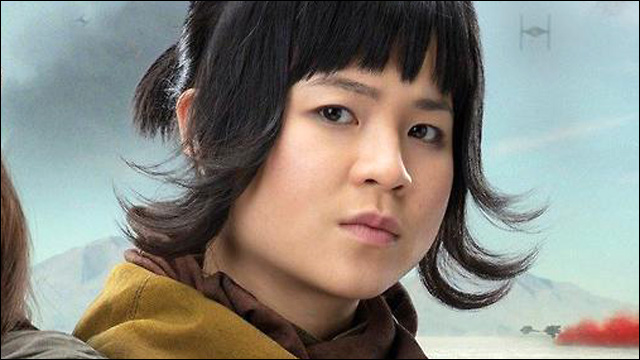I saw Star Wars Episode VIII: The Last Jedi in a packed theater this weekend, and I loved it. No movie is perfect, but this one was close. The Last Jedi stretched the franchise and grew it in ways I hadn’t expected. Finn reappeared and grew as a character, no longer the scared runaway storm trooper just trying to escape. Rey and Luke’s time together, and their discussion of the force, drew me in in a way that left me wanting more. But these were not the things I was most moved and impressed by.
***spoiler warning***
Much will be made of the introduction of a new character, Rose, played by Kelly Marie Tran, a Californian actress whose parents were born in Vietnam. And much should be made of it. There has been a lot of discussion by Asian American actors and feminists in recent years about the portrayal of Asian women in film (see for example “We’re the geeks, the prostitutes“). Rose, in contrast, was not an Asian stereotype.

Unless I very much miss my guess, Rose is the first woman of color to play a substantial role in any Star Wars movie while wearing her own face (see Lupita Nyong’o Gets CGI’d for discussion of The Force Awakens’ Maz Kanata). This matters.
But the Star Wars franchise has had a longstanding problem not just with women of color but also with women in general. Last night I asked my husband if he could think of any women in the original movies who had substantial screen time and a developed backstory, besides Leia. We both came up blank. Google confirmed this—if you take Leia out, women spend less than a minute talking in all of the original movies combined (these lines delivered by Aunt Beru, Mon Montha, and an unnamed rebel).
When Bustle compiled a list of consequential female characters in the Star Wars movies last year, they came to a total of nine—and that included A Force Awakens. Without A Force Awakens—which added Rey, Captain Phasma (who always wears a helmet), and Maz Kanata—that list would be at six, and that’s including Aunt Beru, Mon Mothma, Zam Wensell, and Schmi Skywalker, whose roles were arguably peripheral.
Rose, you see, was not the only significant female character introduced in The Last Jedi. There was also Vice Admiral Holdo. Sure, she doesn’t last through the movie, but she still has far more lines and development than Mon Mothma did.

I wasn’t happy with the inclusion of Vice Admiral Holdo merely because her inclusion gave us another strong, substantial female character. Not in the least! Holdo, you see, played a central role in a story arc that I never thought I would see in a Star Wars film.
Toward the beginning of the film, Poe was demoted by Leia for insubordination that cost the rebel alliance its entire bombing fleet. When the remaining rebel fleet was in trouble, later, being stalked by star destroyers waiting for it to run out of fuel, Poe had a confrontational interaction with Vice Admiral Holdo and then concluded that she didn’t know what she was talking about. He set off on his own scheme, without telling anyone in command, and ultimately took control of the ship, holding Vice Admiral Holdo at gunpoint.
Let’s review a few things. When Leia was injured and the line of succession of power was being reviewed, I got the distinct feeling that Poe hoped he would be chosen (I could be wrong about this, though). Then, when Vice Admiral Holdo is announced, Poe is taken aback. “That’s Vice Admiral Holdo?!” he asks. Sorry dude, but yes, Vice Admiral Holdo is a woman. Deal with it. Poe then confronts Holdo about the plan, not in an asking and listening kind of way. He talks to her in a way many women are very familiar with—as though she doesn’t know what she’s doing.
And here’s the thing—Holdo did know what she was doing. She had a plan, a very good plan, but she was under no obligation to spell it out for Poe, especially given his recent demotion. And guess what? Poe’s plan not only failed, it also ruined Holdo’s plan and led to mass loss of life. Over the course of The Last Jedi, Poe’s actions—each time taken in direct contradiction of the orders of his female superiors—cost the rebels upwards of 100 lives, if not more. And these actions, particularly those taken during his conflict with Vice Admiral Holdo, don’t gain the rebels anything.
People died because Poe refused to believe that decorated female generals and admirals might actually know what they’re talking about.
I was nervous when this storyline was introduced—very nervous. I was practically yelling in my seat, or I would have been if the theater hadn’t been full. The idea that Holdo wouldn’t know what she was talking about was absurd. The idea that she wouldn’t have already thought through the things Poe was yelling at her was utterly ridiculous. I was afraid—so afraid—that Poe’s scheme would work and he’d show up Vice Admiral Holdo and all her cautious, careful planning. And then it didn’t. Instead, the opposite happened. She showed him up.
And as upset as I was at the damage the rebels took as a result of Poe’s stupidity, the storyline’s conclusion left me awed and bowled over. We got to watch a man assume he knew more than a decorated female general, break all the rules and set his compatriots off on a dangerous harebrained scheme, and then have his ass handed to him, by a woman who in fact did know what she was doing.
I hadn’t realized how badly I needed this movie.
I have a Patreon! Please support my writing!















